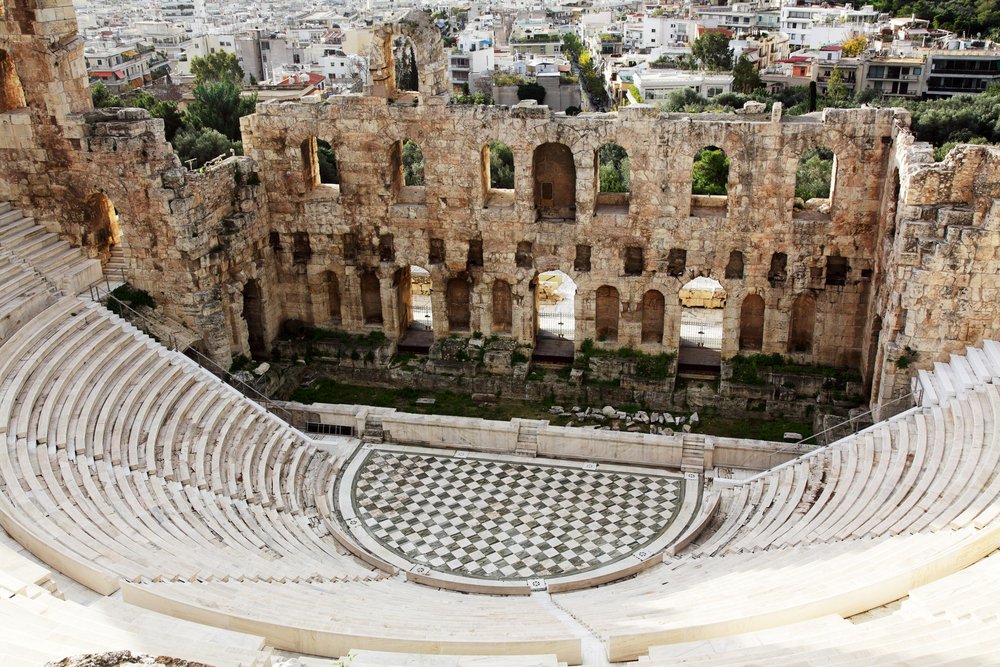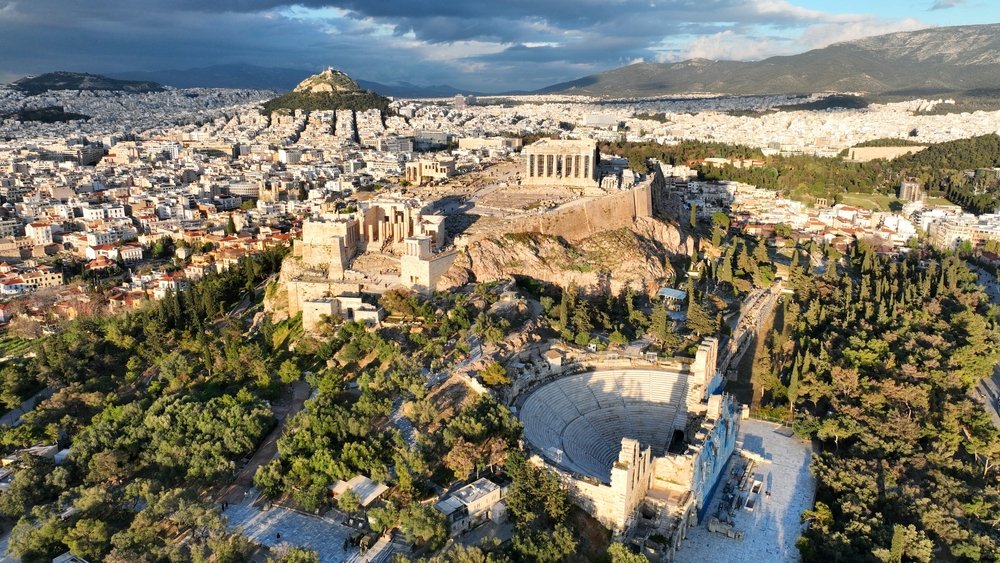Discover the timeless charm of the Acropolis of Athens!
A symbol of ancient civilization and one of the most iconic landmarks in the world. Even if history isn’t your thing, the Acropolis has a way of captivating everyone, from architectural admirers to those just looking for the best view in Athens.Towering above the city, this ancient citadel offers a unique glimpse into Greece’s glorious past and stunning panoramic views of modern-day Athens.
In this complete travel guide, you'll find everything you need to plan your visit: from practical tips and opening hours to the best travel hacks and must-know essentials.
Let’s dive into the heart of Greek heritage.
Top Recommended Tickets for the Acropolis of Athens
Why You Shouldn't Miss the Acropolis of Athens

Perched high above the modern city, the Acropolis of Athens is the crown jewel of ancient Greece and a must-see for anyone visiting the capital. This sacred hill has stood for over 2,500 years, home to legendary landmarks like the Parthenon, the Erechtheion, and the Temple of Athena Nike each a testament to the brilliance of classical architecture and the birthplace of Western democracy.
More than just ruins, the Acropolis is where history, mythology, and art intertwine. As you walk its ancient paths, you’re not just sightseeing: you’re stepping into the heart of Greek civilization. With its panoramic views and timeless beauty, the Acropolis is an experience that leaves a lasting impression on every traveler.
Quick Facts: Acropolis of Athens Visitor Guide

Location: Athens city center, on a rocky hill above Plaka district
Easily visible from most parts of the city and within walking distance from Monastiraki and Syntagma.
>> Open in Google Maps
Recommended Visit Duration: 2 to 3 hours (including exploration of the Parthenon, other temples, and photo stops)
Best Time to Visit: Early morning (8–10 AM) or late afternoon to avoid crowds and heat, especially in summer.
Main Highlights Inside (What Not to Miss)
- Parthenon: The iconic temple dedicated to Athena, and the crown jewel of the Acropolis
- Erechtheion & the Caryatids: Known for its graceful female columns and mythological significance
- Temple of Athena Nike: A small yet stunning temple symbolizing victory
- Propylaea: The monumental entrance that sets the tone for what lies ahead
- Panoramic Views: Breathtaking vistas over Athens, Mount Lycabettus, and even the Aegean Sea on clear days

Athens Acropolis Opening Hours & Best Times to Visit
Acropolis of Athens Opening Hours
The Acropolis is open almost every day of the year, with seasonal time changes:
- Summer season (April–October): 8:00 AM – 8:00 PM (last entry at 7:30 PM)
- Winter season (November–March): 8:00 AM – 5:00 PM (last entry at 4:30 PM)
Closed on: January 1, March 25, May 1, Easter Sunday, December 25 & 26
Tip: Arrive early in the morning when it opens to enjoy the site before tour groups arrive.
Best Time to Visit the Acropolis of Athens
To make the most of your visit, timing is everything. Here’s what to consider:
- Best time of day: Early morning (8:00–10:00 AM) or late afternoon (after 5:00 PM) for fewer crowds and better lighting for photos.
- Best days of the week: Weekdays (especially Tuesday to Thursday) tend to be less crowded than weekends.
- Best season to visit: Spring (April–June) and Fall (September–October) are ideal: pleasant weather, manageable crowds.
- Summer (July–August) is very hot and crowded—go early or opt for a guided sunset tour.
- Winter (November–March) offers quieter experiences and reduced ticket prices, though weather can be unpredictable.
Note: Entry is free on select dates (like the first Sunday of each month from November to March), but these days are often busy.

How to Get to the Acropolis of Athens
The Acropolis is located right in the center of Athens and is easily accessible by foot, metro, or public transport.
Whether you're staying in Plaka, Monastiraki, or Syntagma, reaching the site is straightforward and part of the experience!
On Foot: If you're staying in central Athens, walking is the most scenic way to reach the Acropolis. From Plaka or Monastiraki, you can follow the pedestrianized Dionysiou Areopagitou Street, which winds around the southern slope of the Acropolis and offers beautiful views even before you enter the site.
By Metro: The nearest metro stations are:
- Acropoli Station (Line 2 - Red Line): Just a 5-minute walk to the main entrance via Dionysiou Areopagitou Street
- Monastiraki Station (Line 1 & 3): Around a 10-minute uphill walk, ideal if you're coming from the north or airport
Tip: From Monastiraki, you’ll pass through charming streets and catch first glimpses of the Parthenon above.
By Bus or Tram: While less common, you can also take: Bus lines 230, 035, or 550, stopping near Syntagma or Makrygianni
(Athens Tram to Leoforos Vouliagmenis stop, then a short walk uphill)
Which Entrance Should You Use?
There are two main entrances to the Acropolis:
- Main Entrance (Western side): Near the Propylaea – most popular and direct
- South Entrance (near the Theatre of Dionysus): Less crowded, ideal if you want to combine your visit with the Acropolis Museum or walk up gradually along the slopes
(Both entrances accept standard tickets and combo passes.)

What to Know Before Visiting the Acropolis of Athens
To make the most of your visit, it’s important to come prepared: physically and practically. The Acropolis is a hilltop archaeological site, and while it's incredibly rewarding, it can also be hot, crowded, and physically demanding. Here are the key things to know before you go:
- Wear Comfortable Shoes: The terrain is uneven and often slippery due to centuries of wear on the marble. Sturdy walking shoes or trainers with grip are a must—avoid sandals or anything with smooth soles.
- Prepare for the Heat: If you're visiting in summer, bring a hat, sunglasses, sunscreen, and plenty of water. Shade is limited at the top, and the Greek sun can be intense even in the morning hours.
- What to Bring (and Not Bring):
- Bring: water bottle, camera, ID (if you're eligible for a discounted ticket)
- Avoid: large backpacks (they may be inspected or denied), drones (not allowed), and tripods (require permission) - Accessibility: There is a lift available for wheelchair users and those with mobility challenges at the northeast side of the Acropolis. However, it’s advised to contact the site in advance to confirm accessibility on the day of your visit.
- Respect the Site: The Acropolis is a UNESCO World Heritage Site: avoid touching the structures, stay on marked paths, and follow staff guidance. Climbing on ruins or using flash photography may result in fines.

Travel Essentials for First-Time Visitors in Athens
Planning your first trip to Athens?
Here's what you need to know before you land:
- SIM & Internet
Best option: Buy a local SIM at the airport or from stores like COSMOTE, Vodafone, or WIND - Currency & Payments
Currency: Euro (€)
(Most places accept credit cards, but always carry some cash for small purchases or tips) - Language
Greek is the official language, but English is widely spoken in tourist areas - Emergency Numbers
General emergency: 112
Tourist police (English-speaking): 171
Top 5 Travel Tips for Athens Visitors

- Visit Popular Sites Early (or Late)
The Acropolis and other ancient landmarks get crowded fast—arriving before 9 AM or after 5 PM makes a huge difference in comfort, photos, and queue times. - Eat Where Locals Eat
Avoid tourist traps in Plaka with overpriced souvlaki. For authentic Greek food, try tavernas in neighborhoods like Koukaki, Psiri, or Exarchia—great taste, fair prices. - Always Check Menus (and Prices)
By law, menus must be displayed outside restaurants. Check prices before you sit down, especially in touristy areas, and avoid places that aggressively push you to enter. - Explore on Foot
Athens is surprisingly walkable, and its real charm lies in its narrow streets, local cafés, and random ruins tucked between buildings. Pack good shoes and wander freely! - Keep Your Ticket Stubs
Whether it’s for the Acropolis or a metro ride, hold on to your tickets—ticket inspectors are strict, and some sites offer return discounts with proof of previous entry.
Frequently Asked Questions about visiting Acropolis of Athens

Yes, the Acropolis of Athens is open to visitors throughout the year. Tickets can be purchased online or at the site.
Opening hours vary by season. In summer (April to mid-September), it closes at 7:30 PM. Hours shorten gradually through October, and in winter (November to March), it’s open from 8:00 AM to 5:00 PM.
The best time to visit is in spring (April–June) or autumn (September–October). Visit early in the morning or late in the afternoon on weekdays to avoid crowds and heat.
The most convenient way to get there is by metro—Line M2 (red line) to Acropoli Station. It’s also accessible via bus 230, stopping near the site.
There are two entrances: the main entrance on the west side, and the secondary (less crowded) entrance near the Theatre of Dionysus on the southeast side.
Yes, the Acropolis is partially accessible for wheelchair users. There is a lift and a designated accessible route, though some areas may be challenging due to uneven surfaces.
The Acropolis, Plaka and Anafiotika, Syntagma Square, Temple of Hephaestus, Benaki Museum, Piraeus Temple of Olympian Zeus, Panaghia Kapnikarea Church, Panathenaic Stadium, Athens Riviera, Stavros Niarchos Foundation Cultural Centre, Temple of Poseidon, Lycabettus Hill and Varvakios Agora are some must-visit places in Athens.
A visit to the Acropolis of Athens is more than just a sightseeing stop: it’s a journey into the heart of ancient civilization. With its legendary temples, sweeping views, and rich symbolism, the site offers a truly unforgettable experience.
Plan ahead, go early, wear good shoes, and don’t forget to take a moment to pause and soak in the history beneath your feet. Whether you're exploring on your own or with a guided tour, the Acropolis is a place that will stay with you long after you’ve left Athens.

